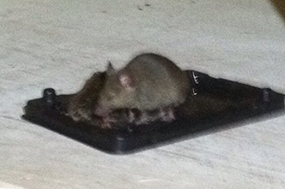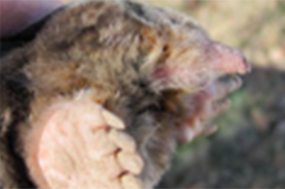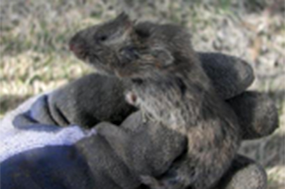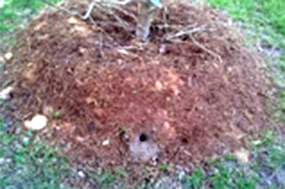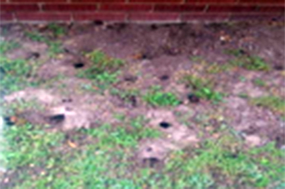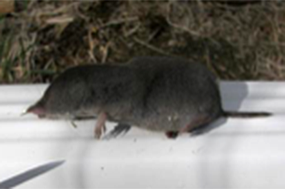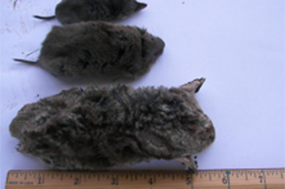Rodent Exclusion
Prevention - In an effort to prevent and eliminate rodent populations, it is important that conditions favorable to their survival and be reduced as much as possible or eliminated.
• Action should be taken to mouse proof the facility by plugging holes in the foundation and walls. Steel wool can be used as a temporary patch while waiting for permanent repair to be done. (Attention should be given to utility tunnels and areas where sewers and drains enter a building.)
• Water runoff should be directed away from the building. Drains should be screened with" hardware cloth to prevent rodent access and kept free of debris to reduce puddling of water.
• Weatherstripping on doors should be repaired or replaced to reduce gaps to less than 1/4". Exterior doors should have automatic closing mechanisms installed and remain closed at all times.
• Loading dock areas should be clean, free of debris and doors should remain closed as much as possible.
• Trees, shrubs, vines and brush should be trimmed away from the building at least 12-18" to allow access for the pest control technician to monitor and place traps and bait stations if necessary.
• Grass should be mowed and trimmed. Keep grass and dirt at least 2 inches below the structure’s foundation.
• Dumpsters should be in good condition with all doors closed and drain holes capped. They should be located away from the building on a paved surface. Trash should be contained.
• Storage areas should be managed using a first in first out program. Inventory should be elevated on pallets or shelving that is 12" or more away from any wall.
• Areas where rodent feces are found should be identified in the pest-sighting log. Taking proper precautions to protect against hantavirus infection. This will help the pest control technician to determine if the infestation is ongoing by whether or not new feces are found after the area has been cleaned.
In addition to structural damage, mice and rats are known to spread organisms such as Salmonella bacteria, eggs of the tapeworm, Hantavirus and Leptospirosis, to name a few. They reproduce an average of 4-8 times per year. They can reproduce more often when conditions are favorable. Litters average 4-12 young. Rodents, particularly Deer Mice, will hoard food. This is an important fact to consider if baits will be utilized for their control. Pelleted, seed or loose meal bait will only be used for outdoor applications and placed in a manner to limit the risk of exposure to unprotected persons and non-target animals. Bait blocks will be anchored properly to prevent mice from carrying bait off to another location.
The selection of pesticides that may be used will be based on a pre-determined hierarchy which will utilize least toxic products as first choice. Proper implementation of this program will reduce the volume, toxicity and frequency of pesticide applications, thereby reducing the risk of potential exposure of building occupants who may be sensitive to their use.
Norway Rats
Norway rats are much larger than mice, usually brown with scattered black. Their tails are shorter than the head and body. They will build a nest of soft materials in and around lower floors of buildings and foundations in burrows, crawlspaces and underneath/behind stationary objects. Rats will range an average of 100-175 feet from their nesting area. They may range farther if food is limited. They are omnivorous, preferring food with a high carbohydrate and protein content. They need water on a daily basis in order to survive. Norway rats will prey upon mice, therefore, they are usually not found living in the same area of a building.
Roof Rats
Roof rats are slender animals. The tail is longer than the head and body combined. The top and bottom of the tail are the same color; color ranges from black to dark gray. The nose or muzzle is pointed, the eyes are large and the big ears cover the eyes if bent forward. They are excellent climbers.
House Mice
House mice are small, light brown to light gray in color with smooth fur. Their tails are longer than their head and body. Mice will nest in walls, ceiling voids, cabinets, drawers, appliances, furniture etc.. They usually nest close by to their food source, with an average range of 10-35 feet. They do not need water on a daily basis. House mice are omnivorous, however, they prefer seeds and grains.
Deer Mice
Deer mice, known vectors of hantavirus, will also enter houses, garages and other structures particularly as cold weather approaches. They are a reddish brown with a white chest and white feet. Their nests are usually underground, however, they will construct nests above ground in areas similar to the House mouse. Deer mice normally breed during spring and fall, however, they will breed more frequently under favorable conditions. They prefer to feed on nuts, seeds, berries and insects.
Voles
The vole is more commonly referred to as a "field mouse" (not the common house mouse) and the Prairie Vole or Meadow Vole is generally what you will find in our area. The vole prefers to feed on seeds, bulbs and tender roots with a fondness for Hostas and other ornamental plants. The voles will even eat the new bark on young trees and girdle the trunk of the tree leaving it open to disease or insects. A vole feeds both day and night and can eat up to twice its weight each day which can cause extensive damage to flower beds, ornamental shrubs, trees and more.
Shrews
The Least Shrew and Short Tailed Shrew are two of the smallest mammals in North America and are the most common in our area of the Midwest. They dig short tunnels and may use the same tunnels as moles and voles by creating numerous dime sized holes in the lawn for access. Like the mole, shrews are insectivores and can be found under leaves, logs, ornamental ground cover and other places where insects are abundant. Researchers have found that shrews reproduce multiple times during the mating season, which generally lasts from February to November. Gestation lasts an average of 21 to 23 days, the young are weaned at around 23 days and reach sexual maturity in approximately 6 weeks. Like moles, shrews must consume plenty of food and generally eat from 60-100% of their full body weight every day.

